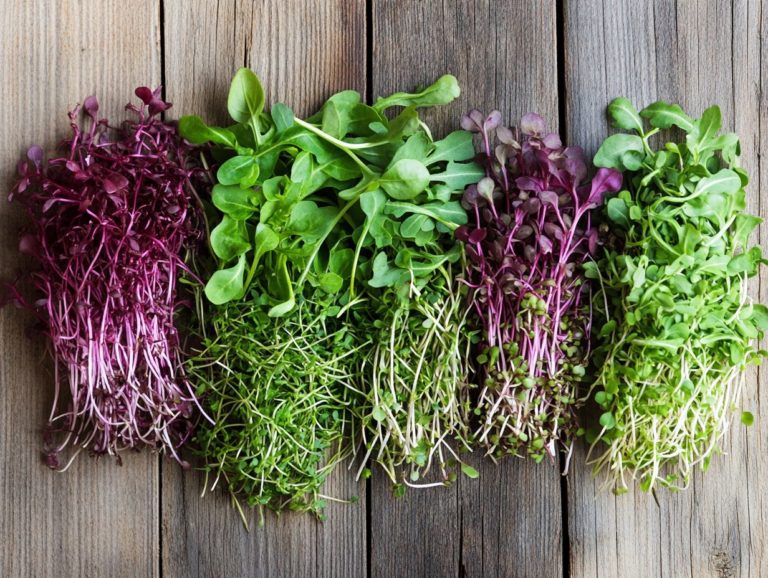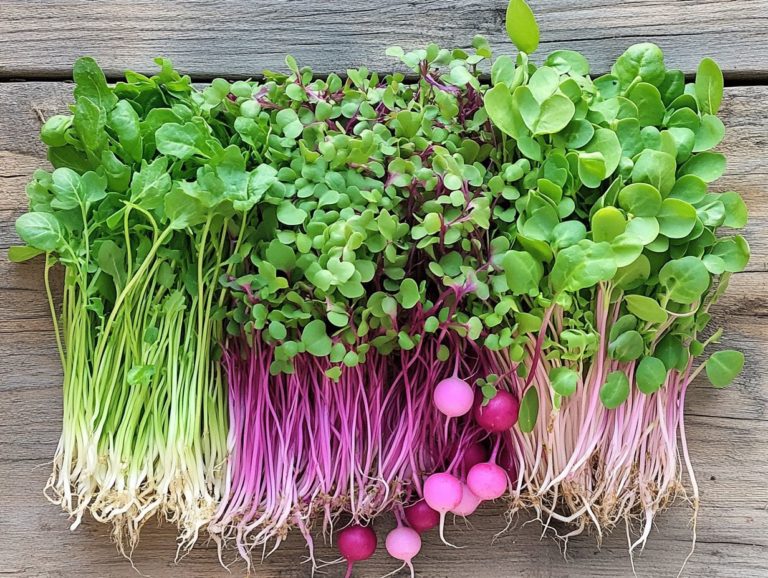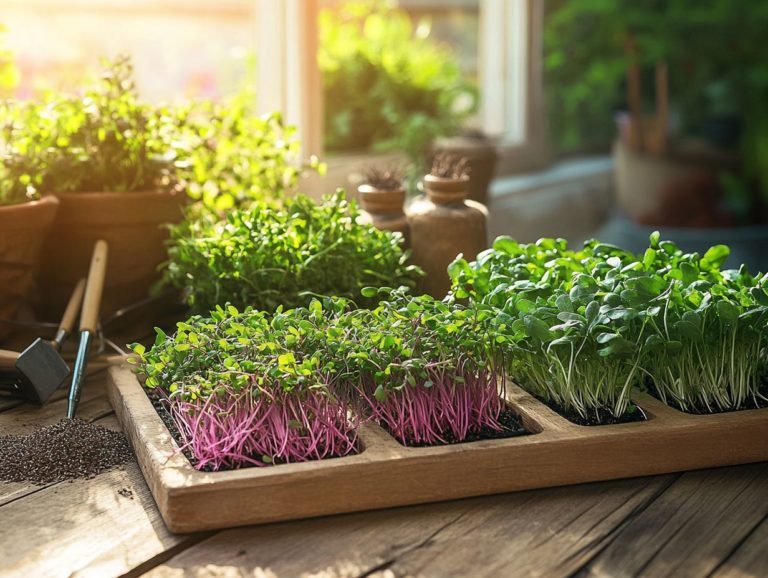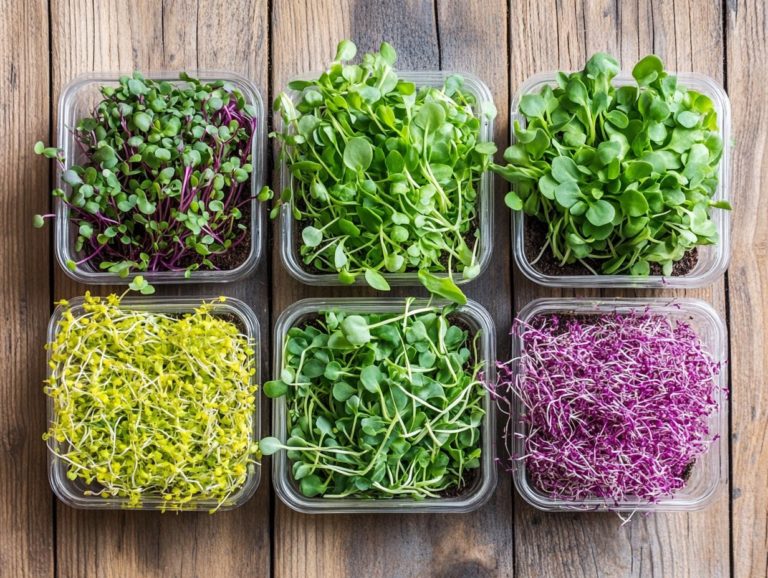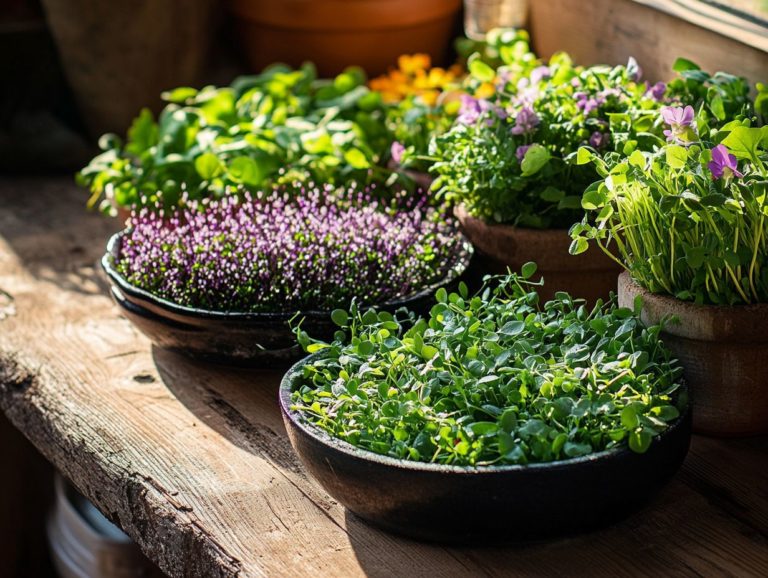Exploring Rare Microgreen Varieties
Microgreens have taken the culinary world by storm, delivering vibrant flavors and a nutritional boost in delightful, tiny packages. But why stop at the common varieties? Rare microgreens can elevate your dishes to new heights. Get ready to transform your meals with these amazing little wonders!
This article will guide you through the definition and benefits of microgreens, highlight some unique varieties, and provide invaluable tips for growing and harvesting them. Discover their impressive health benefits and explore creative culinary uses, as well as where to source these enchanting greens.
Contents
- Key Takeaways:
- What Are Microgreens?
- Rare Microgreen Varieties
- Health Benefits of Rare Microgreens
- Nutrient Profiles and Potential Health Effects
- Culinary Uses for Rare Microgreens
- Growing and Harvesting Rare Microgreens
- Where to Find Rare Microgreens
- Frequently Asked Questions
- What are rare microgreen varieties?
- How do I know if a microgreen variety is considered rare?
- Where can I find rare microgreen varieties?
- Why should I explore rare microgreen varieties?
- How do I store and use rare microgreen varieties?
- Are there any precautions I should take when exploring rare microgreen varieties?
Key Takeaways:
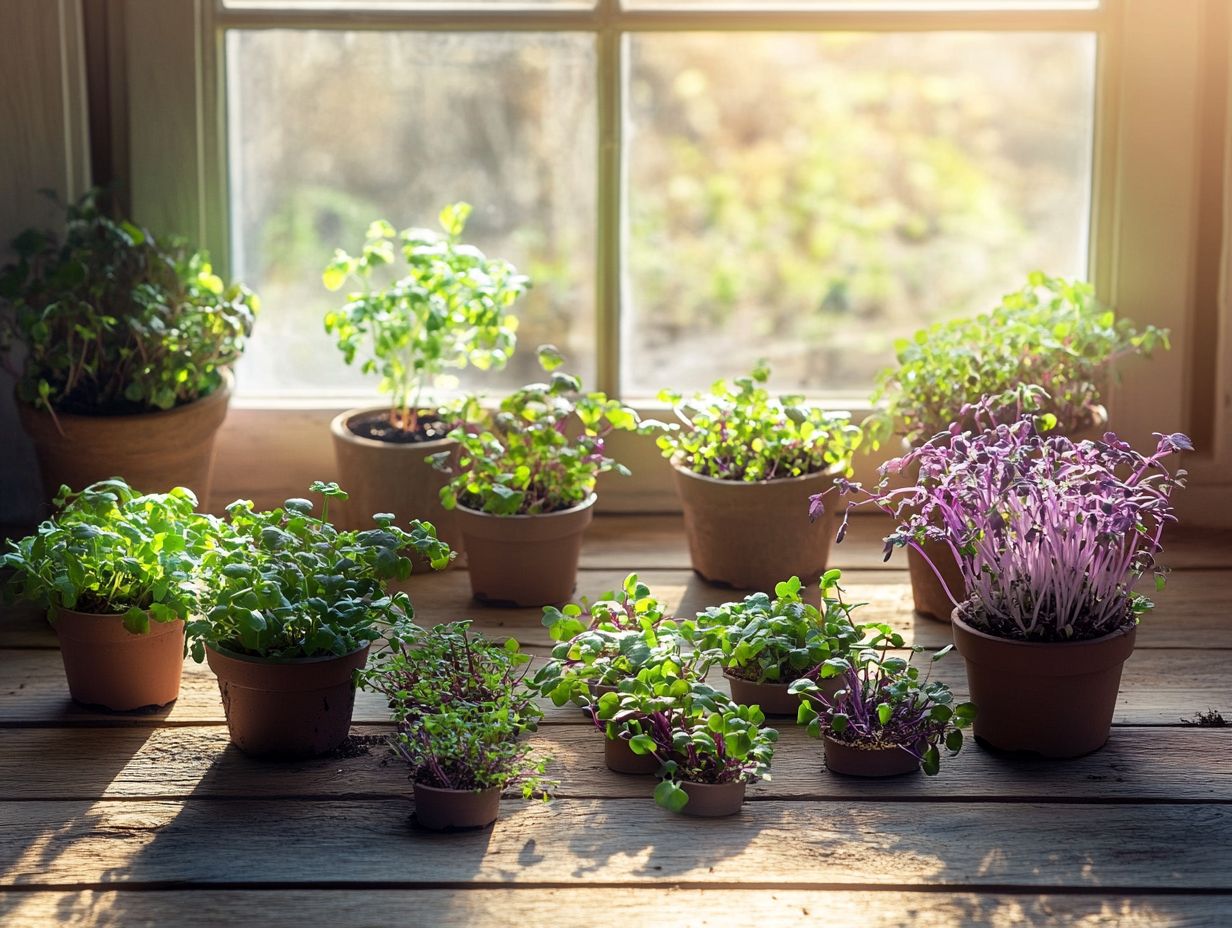
- Boost your health and elevate your meals with rare microgreens, packed with nutrient profiles and potential health benefits.
- Expand your palate and cooking skills by incorporating rare microgreens into your meals in creative ways.
- With the right knowledge and best practices, anyone can grow and harvest rare microgreens, whether purchasing seeds or growing them at home.
What Are Microgreens?
Microgreens are nutrient powerhouses young seedlings picked just after their first true leaves emerge, often displaying vibrant colors and rich flavors. These petite greens not only enhance the visual appeal of your plates but also deliver an intense burst of flavor and concentrated nutrients, making them a go-to choice for health-conscious individuals and cooking lovers alike.
Whether it s the sweet peppery notes of micro basil or the aromatic charm of cilantro, these unique seeds, derived from a variety of herbs and vegetables, open up a world of culinary possibilities. They can elevate your dishes, adding both health benefits and delightful garnishes that truly impress.
Definition and Benefits
Microgreens are essentially young, edible plants that you can harvest at an early growth stage, bringing a wealth of health benefits and enhanced nutrition that surpasses their mature counterparts. These tiny powerhouses are packed with vitamins, minerals, and plant-based nutrients, providing you with a concentrated source of nutrients that can support your overall health. Their vibrant flavors ranging from the spicy kick of radish to the sweet allure of basil add an exciting depth to salads, sandwiches, and various dishes.
They also offer potential health benefits. Many microgreens, such as broccoli and kale, come with medicinal properties, offering antioxidant and anti-inflammatory benefits. By incorporating these greens rich in nutrients into your meals, you not only elevate the nutritional profile but also potentially improve your health outcomes, making them a delightful addition to any diet.
Rare Microgreen Varieties
Rare microgreen varieties like Borage, Shungiku, Nasturtium, and Shiso Perilla are gaining traction for home cultivation, thanks to their unique seeds and exceptional flavor profiles. These microgreens elevate a variety of cuisines, making them a delightful addition to your culinary repertoire.
Description and Growing Tips
Cultivating rare microgreens requires understanding specific growing conditions. These petite greens, celebrated for their vibrant colors and bold flavors, flourish in well-draining, nutrient-rich soil. You can easily achieve this by mixing compost with peat. Adequate light is non-negotiable; they prefer bright, indirect sunlight, or you can opt for grow lights to replicate their ideal environment. Additionally, watering practices are crucial; these microgreens need consistent moisture without becoming waterlogged. Regularly checking the moisture level in the soil can help you prevent damping-off disease. Keeping your microgreens in a warm space between 60 F and 75 F will promote optimal germination and growth.
Health Benefits of Rare Microgreens
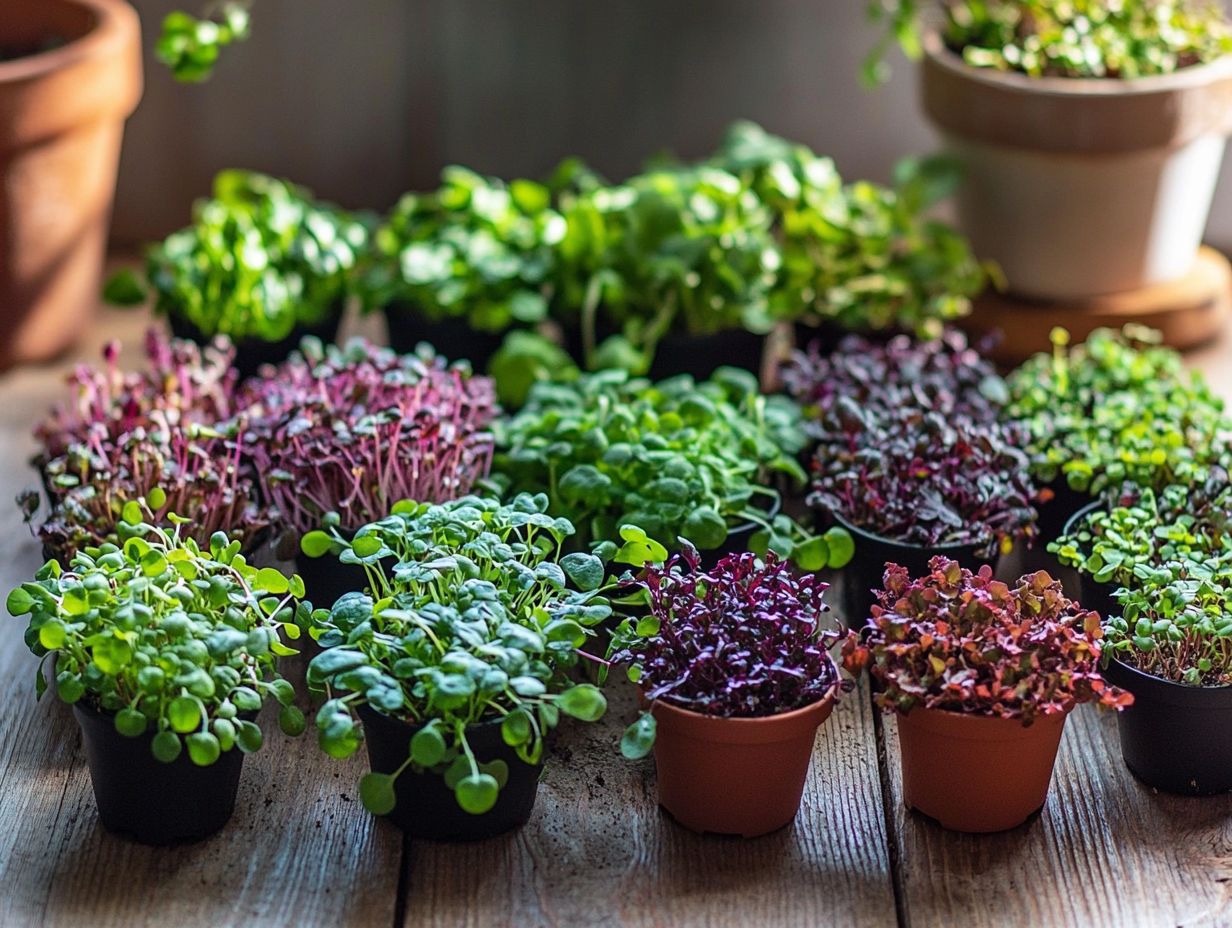
Rare microgreens present a remarkable fusion of nutrient profiles and potential health advantages, enticing health-conscious individuals like yourself who are eager to elevate their diets with these vibrant greens. Dive into the world of rare microgreens and unlock a treasure trove of health benefits!
Nutrient Profiles and Potential Health Effects
The nutrient profiles of rare microgreens reveal a treasure trove of concentrated nutrients, offering a myriad of health benefits, including impressive antioxidant properties and essential vitamins.
Take varieties like red amaranth and sunflower microgreens. They are brimming with vitamins A, C, and K. These greens also contain essential minerals such as calcium and magnesium.
These nutrients are vital for supporting immune function, promoting radiant skin, and fortifying bones. The antioxidants present, including flavonoids and carotenoids, combat cell damage and reduce inflammation.
Incorporating these microgreens into your salads, smoothies, or as garnishes on various dishes elevates flavor and significantly enhances the nutritional value. This paves the way for a healthy and vibrant lifestyle.
Culinary Uses for Rare Microgreens
Rare microgreens are your secret weapon in the kitchen. They serve as versatile ingredients that bring intense flavors and vibrant colors to the table.
Whether you’re enhancing a simple salad or crafting a gourmet meal, these tiny greens elevate your culinary creations to new heights.
Creative Ways to Incorporate into Meals
Incorporating rare microgreens into your meals is a delightful way to boost flavor and nutrition, transforming everyday dishes into culinary masterpieces.
These tiny greens, brimming with essential vitamins and minerals, deliver a burst of freshness. A vibrant salad adorned with a medley of colorful microgreens captivates the eye and tantalizes the palate.
Adding microgreens as a garnish to your soup introduces a refreshing contrast. This enhances both its visual appeal and flavor profile.
Whether you sprinkle them atop a savory sandwich or blend them into a smoothie, these nutrient-dense toppings elevate the presentation and depth of any meal.
Growing and Harvesting Rare Microgreens
Cultivating and harvesting rare microgreens requires specific best practices for optimal growth and flavor. Following these guidelines makes growing microgreens a fun and rewarding adventure!
Best Practices for Growing and Harvesting
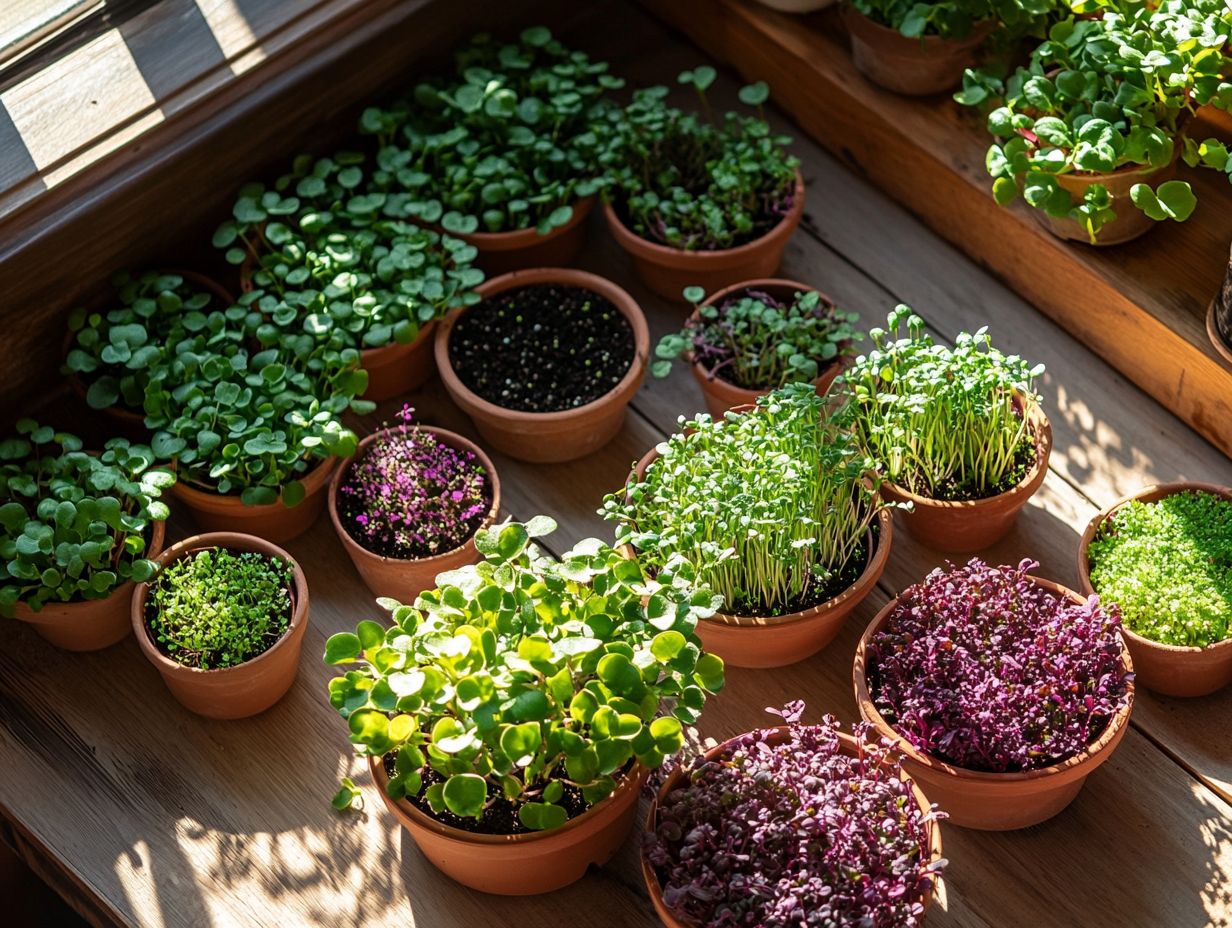
Embracing best practices for growing and harvesting microgreens is essential for unlocking their fullest flavor and nutritional potential.
Start by focusing on soil preparation. A light, well-draining mix that’s packed with nutrients lays the groundwork for success.
Establishing a proper watering routine is equally important. Striking the right balance is crucial over or under-watering can stifle growth or lead to undesirable flavors. Ensure your microgreens receive about 12-16 hours of light each day to help them develop vibrant colors and robust flavors.
When it’s time to harvest, use clean, sharp scissors to cut the greens just above the soil line. This minimizes damage and encourages regrowth, ultimately enhancing yield and quality.
Where to Find Rare Microgreens
Embarking on the quest for rare microgreens is an exhilarating experience. Numerous sources present exciting opportunities to discover unique seeds for home cultivation.
Reputable suppliers such as True Leaf Market lead the way in providing quality seeds.
Ready to boost your meals with rare microgreens? Start your journey today!
Sources for Purchasing or Growing Seeds
When looking for reliable sources to purchase or grow microgreen seeds, True Leaf Market is an excellent choice for gardening enthusiasts.
True Leaf Market, along with other reputable online retailers like Johnny’s Selected Seeds and Seeds of Change, offers a wide selection of quality seeds designed for microgreens. For those interested in exploring different types, microgreen varieties: a guide for beginners can be a valuable resource. Local gardening centers and farmers’ markets also provide options, often featuring organic seeds that are well-suited for your area.
Choosing quality seeds is crucial for the success and flavor of your microgreens. A diverse array of seeds can enhance your yield and culinary experience, allowing you to explore various flavors and enjoy numerous nutritional benefits.
Frequently Asked Questions
What are rare microgreen varieties?
Rare microgreen varieties are lesser-known types that are not as commonly found or grown as traditional microgreens. They often have unique flavors, textures, and colors that make them highly sought after.
How do I know if a microgreen variety is considered rare?
A microgreen variety can be considered rare based on its availability and popularity. If it s hard to find and not widely grown, it s likely rare. Research or consult an expert to confirm its rarity. Popular examples of sought-after varieties include micro basil and Shiso Perilla.
Where can I find rare microgreen varieties?
Rare microgreen varieties can be found at specialty farmers’ markets, online seed stores like True Leaf Market, and small-scale local farmers. You can also try growing them yourself using rare seeds and following gardening tips for optimal growth.
Why should I explore rare microgreen varieties?
Exploring rare microgreen varieties allows you to discover unique flavors, textures, and colors that traditional microgreens may lack. This not only enhances your meals but also supports small-scale farmers and promotes biodiversity in our food system.
Start your journey into the world of microgreens today and unlock a vibrant culinary adventure!
How do I store and use rare microgreen varieties?
Store rare microgreens in a cool, dark place to keep them fresh. You can use them just like traditional microgreens add them to salads, sandwiches, and smoothies or use them as a colorful garnish.
These vibrant greens add a delicious flavor boost to any dish. Don’t miss out on the exciting flavors they bring to your meals!
Are there any precautions I should take when exploring rare microgreen varieties?
Research potential allergens or harmful effects linked to rare microgreens before trying them. If you have allergies or health concerns, consult a healthcare professional, especially for varieties with known medicinal benefits like Echinacea.

